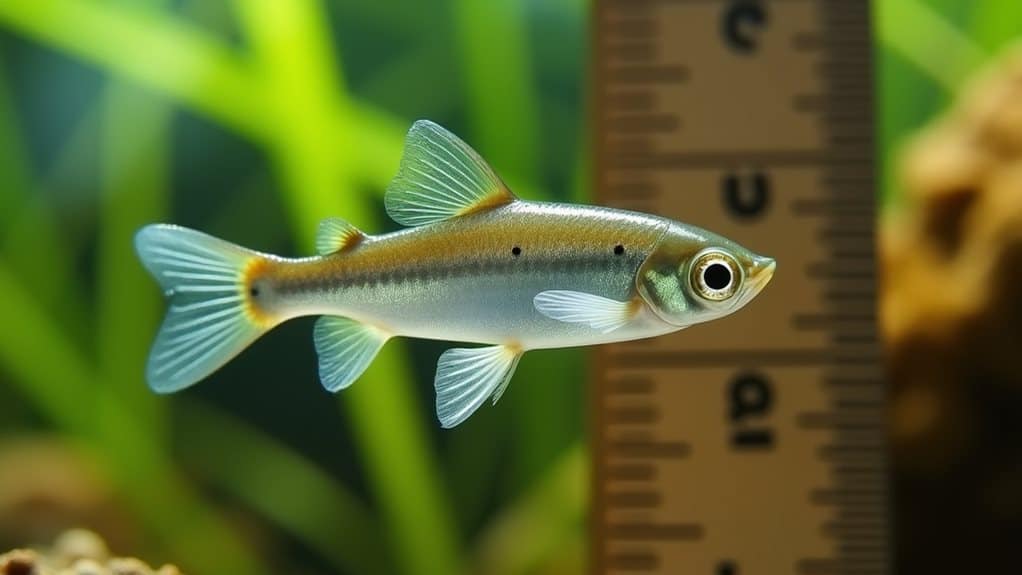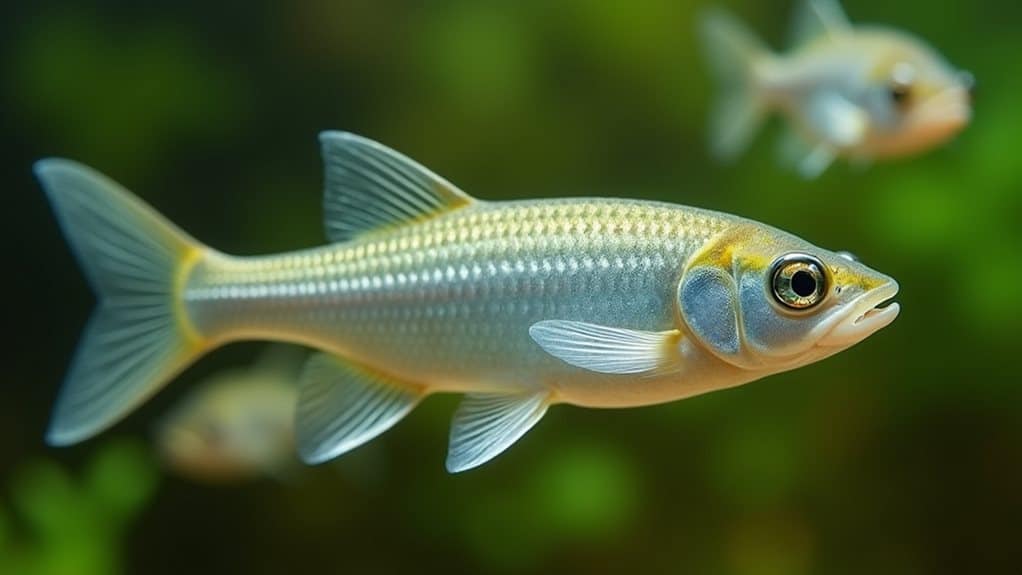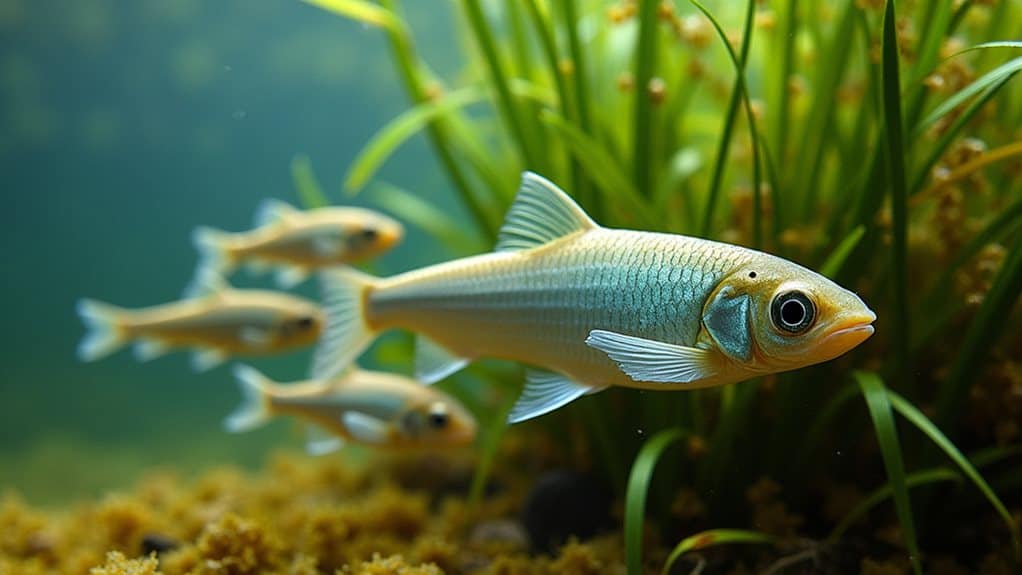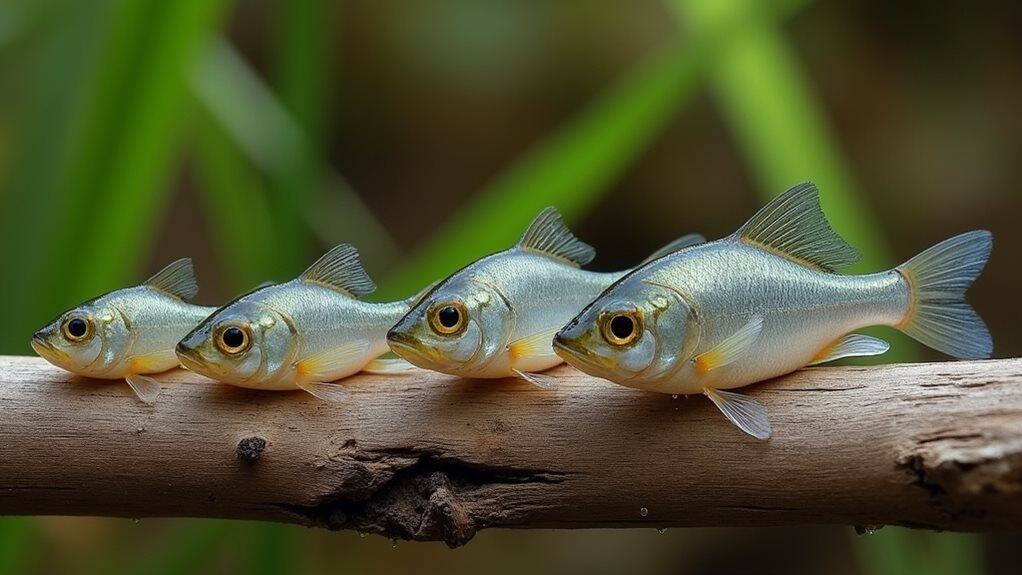You’ll find that fathead minnows typically grow between 1.5 to 4 inches in total length, with most adult specimens averaging around 2 inches. Wild populations can reach up to 3 inches, while males generally grow larger than females during breeding season. These compact fish experience rapid growth from tiny 4-5mm hatchlings to nearly 2 inches within just 90 days, though their growth considerably slows after reaching maturity. Environmental factors like water temperature and quality directly influence their final size, and there’s much more to understand about their development patterns.
TLDR
- Fathead minnows typically measure 1.5 to 4 inches in total length, with common adults averaging around 2 inches.
- Wild populations can reach up to 3 inches maximum, while mature males are generally larger than females.
- Males weigh 3-5 grams at maturity, whereas females weigh 2-3 grams when fully grown.
- Young minnows grow rapidly from 4-5mm hatchlings to nearly 2 inches within just 90 days.
- Water temperature, quality, food availability, and habitat conditions significantly influence their final adult size.
Average Size Range and Typical Measurements

Fathead minnows are consistently small fish that typically measure between 43 to 102 millimeters in total length, which translates to roughly 1.5 to 4 inches for most adults you’ll encounter. Their small size makes them ideal for kayak fishing as they can easily be found in various water bodies.
Common adult specimens average around 50 millimeters (2 inches), though wild populations often reach 73 millimeters (3 inches), with mature males slightly larger than females. During breeding season, males develop distinctive nuptial tubercles and display more vibrant coloration with sides becoming almost black featuring two wide light-colored vertical bands.
Physical Body Characteristics and Proportions
Beyond their modest size, these small freshwater fish display a distinctive body structure that’s both compact and sturdy. You’ll notice their deep, laterally compressed bodies create a stout appearance, while their blunt, rounded snouts and dorsally flattened heads give them a characteristic profile. The broad, flat surface before their dorsal fin distinguishes them from other minnow species. This area is covered with smaller scales compared to the rest of their body, creating a unique textural variation along their profile. Additionally, their physical activity encourages them to thrive in various freshwater environments, contributing to their adaptability.
Growth Rates and Lifespan Development

You’ll find that fathead minnows experience incredibly rapid growth during their juvenile stage, changing from tiny 4-5 mm hatchlings to nearly 2-inch fish within just 90 days.
This explosive early development slows considerably once they reach maturity, but it’s balanced by their relatively short lifespan of 1-3 years in natural environments.
Understanding these growth patterns helps explain why fathead minnows can maintain stable populations despite high mortality rates, particularly after their first spawning season. Additionally, their adaptability to different water environments can contribute to better overall fitness and survival in varying conditions.
Rapid Juvenile Growth Patterns
When juvenile fathead minnows first hatch, they commence on an impressive growth expedition that’ll see them reach 45-50 mm in just 90 days.
You’ll find their development remarkably swift, with fish becoming mature by 84 days post-stocking and beginning reproduction around 112 days.
This accelerated timeline means they’re completing their entire life cycle within approximately one year.
Three Year Life Expectancy
The biological clock of fathead minnows operates on a compressed timeline, with most individuals reaching their maximum lifespan of three years under ideal conditions.
You’ll find that wild populations typically average two to three years, with environmental factors like water temperature greatly influencing growth rates.
Post-spawning mortality dramatically affects longevity, as adults often die within 30-60 days after reproduction.
Size Differences Between Males and Females
Although fathead minnows start life looking virtually identical regardless of sex, males and females develop distinct size differences as they reach reproductive maturity at 4 to 5 months old.
You’ll notice males become larger and heavier, measuring 3-5 grams compared to females’ 2-3 grams, while developing distinctive features like dorsal pads and pronounced tubercles. This size difference can be compared to the importance of gender roles in other species, highlighting how physical traits can signify reproductive fitness.
Environmental Factors Affecting Growth

Beyond genetics and sex, your fathead minnows’ ultimate size depends heavily on the environmental conditions they experience throughout their lives.
Water temperature greatly impacts growth rates, with moderate warmth promoting ideal development while extreme heat causes abnormalities.
Water quality, including pH and oxygen levels, affects growth hormones like IGF1.
Food availability, photoperiod changes, and habitat stressors also influence their final size.
Size Comparison With Similar Minnow Species
When comparing fathead minnows to their relatives in the minnow family, you’ll find they occupy a small to medium position in the size range.
Ghost shiners rarely exceed 5 cm, making them smaller than fatheads.
However, common creek chubs grow up to 12 inches, and Colorado pikeminnows can reach 6 feet, dwarfing fathead minnows considerably.
Regional Variations in Body Length

Across their extensive North American range, fathead minnows maintain remarkably consistent body sizes, with most adults reaching 7-10 cm (2.8-3.9 inches) regardless of their geographic location.
Whether you’re examining populations in Canadian prairie potholes or southern Gulf Coast drainages, you won’t find significant regional size variations.
Even introduced European populations display similar adult dimensions.
Final Note
You now understand that fathead minnows typically reach 2-4 inches in length, with males growing slightly larger than females. Their growth depends on water temperature, food availability, and habitat quality, while regional variations can influence their final size. Compared to other minnow species, they’re relatively small but hardy fish. Whether you’re using them as bait, for pond management, or aquarium keeping, you’ll find these adaptable minnows maintain consistent size ranges across different environments.




